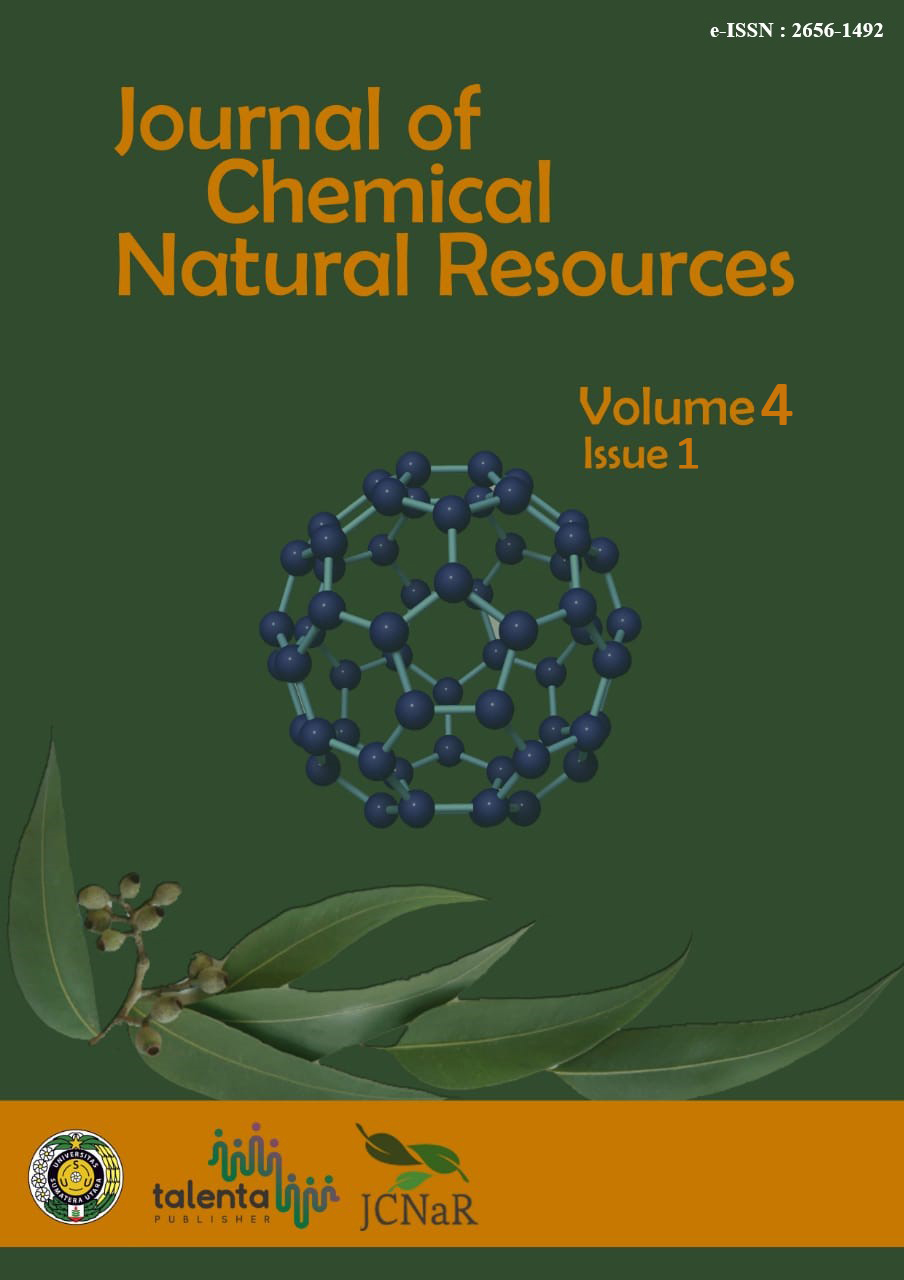Phytochemical of Ethanolic Extract of Cabbage (Brassica oleracea) Collected from Medan, Indonesia
DOI:
https://doi.org/10.32734/jcnar.v4i1.10207Keywords:
Cabbage, Phytochemical, FlavonoidAbstract
Phytochemical screening of ethanolic extract of cabbage (Brassica oleracea) has been successfully conducted. A phytochemical test was performed using FeCl3 to know the content of the phenolic compound from Cabbage. Cabbage is extracted until the ethanolic extract was obtained. It contained secondary metabolic compounds. mengandung senyawa metabolic sekunder. The largest secondary metabolic in cabbage extract was the flavonoid compound. The flavonoids total contained in the ethanolic extract of cabbage was 1.68 mg QE/g extract and the level of total phenol contained in the ethanolic extract was 45.090 mg GAE/g extract.
Downloads
References
Akbar, R. (2015). Aneka Tanaman Apotek Hidup Di Sekitar Kita. Cetakan I. Jakarta: One Books. Hal. 114
Akinmoladun AC, Olowe JA, Komolafe K, Ogundele J, Olaleye MT, 2016. Antioxidant Activity and Protective Effects of Cocoa and Kola Nut Mistletoe (Globimetula cupulata) Against Ischemia/Reperfusion Injury in Langendorff-perfused Rat Hearts. Journal of Food and Drug Analysis, 24:417–426.
Masaki, H. (2010). Role of antioxidants in the skin: anti-aging effects. Journal of dermatological science, 58(2), 85-90.
Sembiring HB, Barus T, Marpaung L, 2015. Antioxidant and Antibacterial Activity of Some Leaves Extracts (Methanol, Ethyl Acetate, and N-Hexane) of Scurulla fusca G.Don. International Journal of PharmTech Research, 8:24–30.
Percival, I. (1998). Quantum state diffusion. Cambridge University Press.
Ruban P, Gajalakshmi K, 2012. In Vitro Antibacterial Activity of Hibiscus rosa-sinensis Flower Extract Against Human Pathogens. Asian Pacific Journal of Tropical Biomedicine, 2:399–403.
Unuofin JO, Otunola GA, Afolayan AJ, 2017. Phytochemical Screening and In Vitro Evaluation of Antioxidant and Antimicrobial Activities of Kedrostis Africana (L.) Cogn. Asian Pacific Journal of Tropical Biomedicine, 7:901–908.
Pretorius JC, Magama S, Zietsman PC, 2003. Purification and Identification of Antibacterial Compounds from Euclea crispa subsp. crispa (Ebenaceae) Leaves. South African Journal of Bothany, 69:579–586.
Osadebe PO, Okoye FBC, Uzor PF, Nnamani NR, Adiele IE, Obiano NC, 2012. Phytochemical Analysis, Hepatoprotective and Antioxidant Activity of Alchornea cordifolia Methanol Leaf Extract on Carbon Tetrachloride-induced Hepatic Damage in Rats. Asian Pacific Journal of Tropical Biomedicine, 5:289–293.
Puneetha GK, Thriveni MC, Murali M, Shivamurthy GR, Niranjana SR, Prakash HS, Sadashiva MP, Amruthesh KN, 2013. Evaluation of A Parasitic Flowering Plant Dendrophthoe trigona (Wt. & Arn.) Danser for Its Phytochemical and Antioxidant Activities. Journal of Pharmacy Research, 7:20–23.
J. B. Harborne, Phytochemical Methods (Chapman and Hall, London and New York, 1984.
Ditjen POM, Farmakope Indonesia (Departemen Kesehatan Republik Indonesia, Jakarta, Indonesia, 1995.
Silalahi, J. (2006). Makanan Fungsional. Yogyakarta:Kanisius. Halaman 22-29, 54.
Sandrasari, D. A. 2008. Kapasitas antioksidan dan hubungan nilai total fenol ekstrak sayuran Indigenous. Sekolah Pascasarjana. Institut Pertanian Bogor. (Tesis).
Hertiani, T., Pramono, S., dan Supardjan A M. (2000). Uji Daya Antioksidan Senyawa Flovonoid Daun Plantago major L. Majalah Farmasi Indonesia 11 (4).
Downloads
Published
Issue
Section
License
Copyright (c) 2022 Journal of Chemical Natural Resources

This work is licensed under a Creative Commons Attribution-ShareAlike 4.0 International License.















